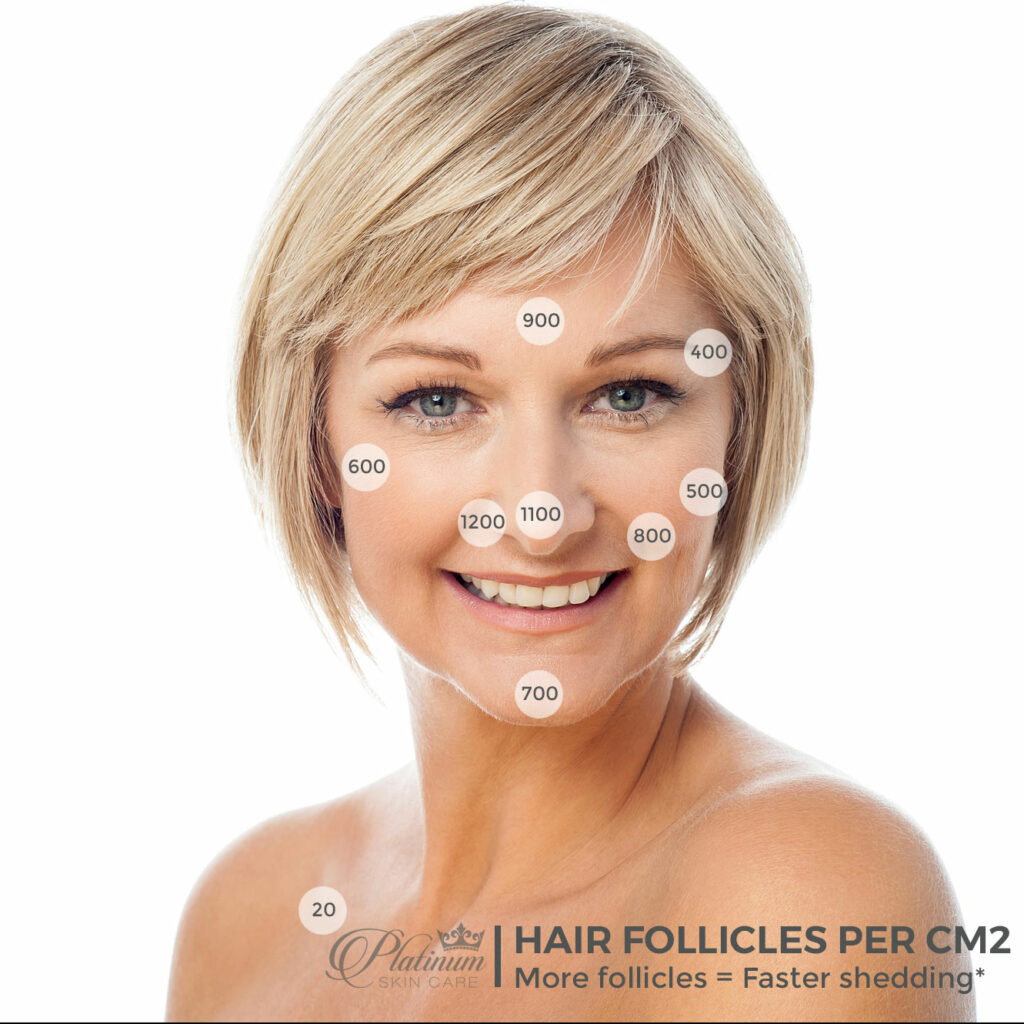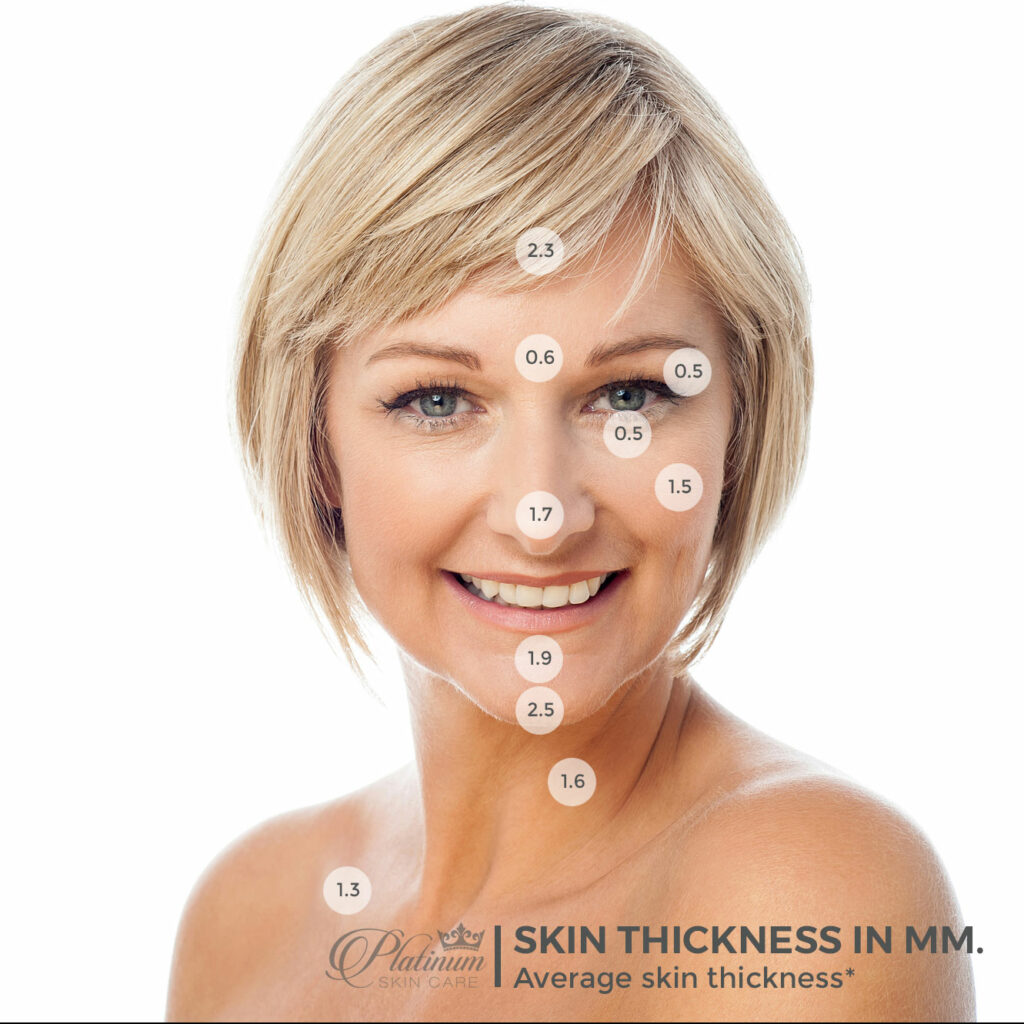Transcript: Ok, welcome back to Unit #2, Lesson #2 of Peel University.
Today we need to take a minute & talk about HEALING TIMES.
If I could hit the easy button on this one and make sure you could peel any day you wanted, never have to peel and see an amazing transformation in a few weeks I would probably break it!
I wish it were that simple but it’s not, so we need to talk about healing because this is such any important part of your peel routines.
It’s all about how quickly the skin can turnover after each peel.
Is it going to take 5 days? 7 days? 10 days? Or even 30 days? This is entirely dependent on where you are peeling.
The face always peels the quickest at maybe 5-10 days and the body can take upwards of 30-35 days to completely turnover … but why?
It has to do with our follicles!
The more sebaceous follicles that we have in the skin – the quicker it will heal. Look at this picture and get an idea of how this works. Each number represents how many follicles per square centimeter.

They are important because they extend all the way into the deepest tissue layers. The more follicles there are – the quicker the turnover. This is because the new skin moves up quickly from where the follicle is connected to the deeper layers.
In areas where there are low counts of follicles, it will take a longer time to heal. Did you notice that the chest has only 20 and everywhere on the face has at least 400 to 1100? That means that the chest will take a much longer time to regenerate and heal after a chemical peel than a facial treatment.
The rest of the body is the same way, with the hand having about 20 and the back about 90. Keep this in mind moving forward so you start to understand why some areas will take longer to flake than others.
*Many people start panicking that a peel didn’t work since it is taking “so long” to flake. But the proof is in the body part.
Since we just learned about the layers and how fast the skin will turn over, let’s take a minute to think about the body and all the different areas of skin. Some are very thick and others, like the face, are much thinner. This too will play a part in how fast the skin sheds. .. but it also will help you to understand why some areas require a deeper peel than others.

The thinnest skin on the face is the eye area which is about 0.5mm and on the contrary, the thickest is on the bottom of the foot at 4mm. You will find the average body parts to be between 2-3mm thick.
We always want to use gentler acids on the thinnest areas such as the eyes.
You can then get progressively stronger on the other areas of the face and body. Each person is different though, and your skin can change as you age. Most notably in your 50’s and 60’s.
Some will get very thin skin that needs to be treated very gingerly with mild hydroxy peels.
Others that have spent years in the sun can have thick, weathered skin with lots of UV damages. Superficial peels may not give the desired outcome and a medium peel may be necessary.
Caution will have to be warranted though as older skin will take a much longer time to regenerate than younger skin. Which is why we encourage faster turnover in the skin with a retinoid regimen prior to applying peels.
So, it’s time to honest about where you are & what kind of skin you have.
Which is why we don’t jump right in & start with the highest acids and layers. If you go to quickly you can create too much damage and stop the benefits of a peel altogether.
This is why we created Peel University. We have your back and will get you peeling in no time.
We just need to learn about acids next so you can make your choice!

10 Responses
Hi there, I had a Co2 resurfacing laser done on face & neck about 18mths with great results..a lot of fluid, swelling, seeping & peeling involved!
I had a v.good result..but have now gone back to how I was before the laser..I have sun damaged, wrinkled Aussie skin..I was wanting to do a TCA 20% as I think my skin can cope after what I had done with the laser?
What are your thoughts please.
Kind regards Deborah
Hello Deborah, we answered this here: https://peeluniversity.com/peel-university-live-qa-october-7th-2021/
eye opener
I have good skin overall except for scarring im chin area fr cystic acne
which still flares up with no warning so I have been using retin a for 30 yrs which helps somewhat, and have been preventing wrinkles with sun screen since I was in my twentys.I use a red light mask regularly and microneedle every month or so and use the Tria – I have done the mandolic acid peel 25% and my big question is can I do the mandolic acid peel if my skin can take it with in conjunction of all these other procedures which are all diy except for botox 2x a year.
Yes… mandelic 40 weekly or every other week would be great.
Daily:
am: AB Cleanser + Vitamin B Complex
pm: AB Cleanser + Fusion A ( or your tretinoin) + B Complex
I swim 3-4 a week, how long do I need to wait after each peel to swim again? Should I stop completly until the series is done? Thank you
Is it recommended? Ummm No. … But he/she does it?
So let’s think about chlorine. Basically it is like diluted bleach to keep the water sanitized. It works well and is very drying if you swim consistently.
Couple that with skin that you just did a peel on? Well… you can see that it may get too irritated and it will definitely get drier.
We do have people that swim regularly without issue. So if you MUST swim… we suggest the following:
Try not to swim within a few days of applying that peel. Depending on the layers applied, it can cause sensitivity. Redness, irritation.
Apply LOTS of a protectant prior to getting in that pool. Think protectants like emu oil or aquaphor or both!
Do not swim for long periods.
Wash after swimming and apply your healing products again (emu oil or Essentials Healing Blend and aquaphor) to protect the skin.
Any excess irritation or redness would warrant avoiding the pool until that goes away. Not everyone can get away with this.
Our best suggestion is you can test this out and see how it works. If you are irritated at all – then stop there instead of going another time.
Hi Jen. I’m Irene and I’m in the UK. what’s the equivalent of Emu Oil that I can use. Thanks
Hello there. We have created our Essentials Healing Blend to be an alternative to the emu oil. Here is a link to that: https://www.platinumskincare.com/essentials-healing-blend-99-organic/ It has the same anti-inflammatory and healing capabilities. 🙂
Hello. Yes, we have our Essentials Healing Blend that is 99% organic and has the same properties as the emu oil for healing. Anti-inflammatory, anti-bacterial, soothing and healing. You can find that here: https://www.platinumskincare.com/essentials-healing-blend-99-organic/
We are no longer able to export the emu oil due to the Fish & Wildlife here in the USA. Hopefully one day that will change again.